Home » SWICo News
Category Archives: SWICo News
Seconda Edizione Premio Franco Mariani
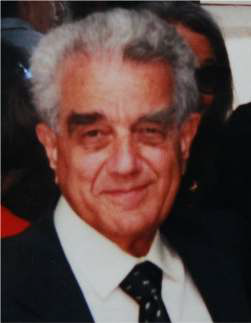
Il Gruppo Nazionale SWICo intende rendere omaggio alla memoria del prof. Franco Mariani, personalità scientifica di rilievo in ambito internazionale, pioniere e protagonista dello sviluppo della ricerca spaziale in Italia, con l’istituzione del Premio “Franco Mariani” per giovani laureati magistrali in discipline inerenti lo “Space Weather” (https://swico2024.it/premio-mariani/).
Il premio è rivolto a giovani laureati magistrali in discipline inerenti lo Space Weather.
La scadenza per l’invio delle domande di partecipazione al premio è il 30 Luglio 2024.
Convocazione dell’Assemblea per il rinnovo delle cariche sociali
In ottemperanza a quanto previsto dal Regolamento Elettorale della Space Weather Italian Community (SWICo), l’Assemblea per il rinnovo delle cariche sociali di Presidente e del Consiglio Direttivo per il triennio 2025-2028 si svolgeranno nel corso del Terzo Congresso SWICo che si terrà presso l’Agenzia Spaziale Italiana, Roma, nei giorni 27-29 Novembre 2024.
Si ricorda che Il Consiglio Direttivo è composto dal Presidente e da un numero di Consiglieri (variabile, ma non superiore a sette) eletti dall’Assemblea.
Possono partecipare alle operazioni di voto tutti i Soci effettivi, che costituiscono l’elettorato attivo
e passivo. La votazione avverrà esclusivamente in presenza. L’Assemblea è validamente costituita
qualunque sia il numero dei Soci presenti.
La normativa relativa alla presentazione delle candidature e allo svolgimento delle elezioni è
definita nel Regolamento Elettorale.
Il decreto di convocazione firmato dal presidente è visibile in calce e scaricabile dal modulo sottostante:
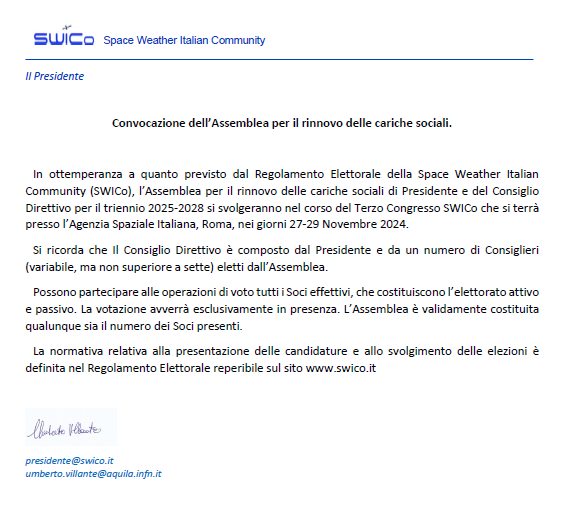
Terzo Congresso Nazionale SWICo
Il Terzo Congresso SWICo intende essere un momento di incontro e confronto dell’intera comunità italiana impegnata nelle discipline in questione. Il Congresso è pertanto aperto anche ai non appartenenti a SWICo. E’ inoltre particolarmente incoraggiata la partecipazione attiva di studenti, dottorandi e giovani ricercatori.
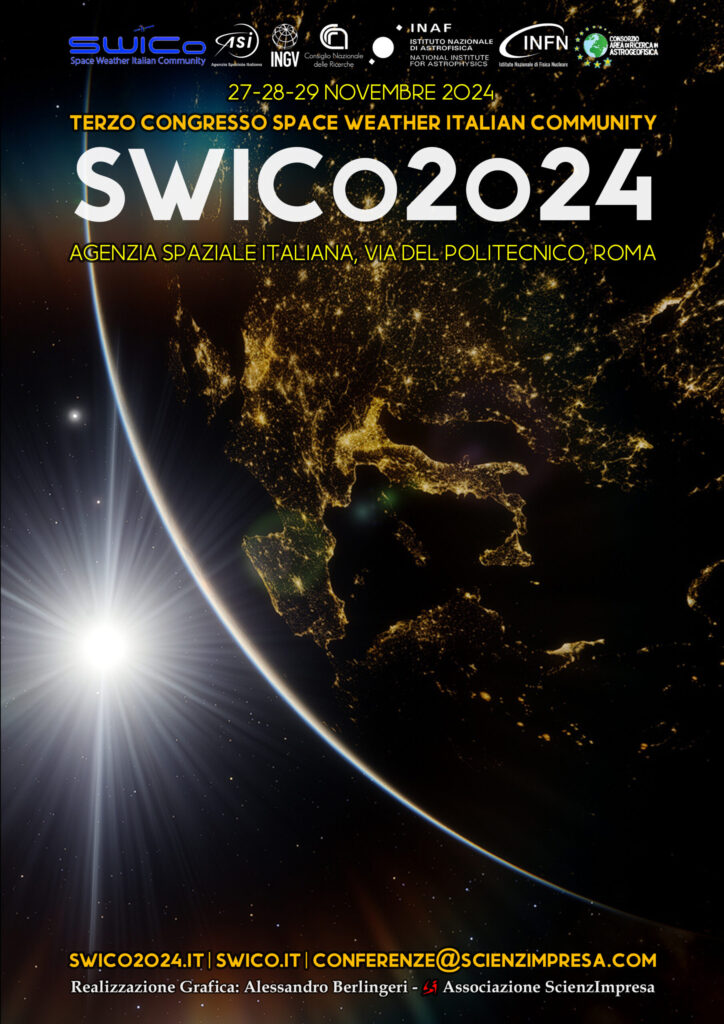
Al tal fine, il Consiglio Direttivo, compatibilmente con le risorse disponibili, intende favorire la partecipazione gratuita di personale in formazione e assegnare un premio ai migliori contributi (orali e/o poster) da parte dei giovani.
Il congresso si svolgerà presso la sede centrale dell’Agenzia Spaziale Italiana il 27-28-29 Novembre 2024.
Per la deadline per l’invio dei contributi ed ulteriori informazioni si rimanda al sito dedicato al congresso: https://swico2024.it/
Nell’ambito del Congresso verrà anche tenuta l’Assemblea Generale per il rinnovo degli Organi Statutari.
Il Congresso offrirà, inoltre, l’opportunità del conferimento del Premio “Franco Mariani” (giunto alla seconda edizione), istituito per onorare la memoria di una personalità scientifica di statura internazionale, promuovendo il coinvolgimento di giovani ricercatori nelle discipline inerenti lo Space Weather.
17th European Solar Physics Meeting – Turin, 9-13 September 2024

Dear colleagues,
this is the second announcement for the 17th European Solar Physics Meeting (ESPM-17) that will take place in Turin (Italy) in the period 9-13 September, 2024.
ESPMs are organized by the Board of the European Solar Physics Division (ESPD), a Division of the European Physical Society (EPS). This will be the first in-person ESPM after the stop due to the worldwide pandemic.
The scientific program of the next ESPM meeting will be organized around the following topics:
- Solar interior, sub-surface flows and long-term variability
- Fundamental mechanisms of solar plasmas: magnetic reconnection, waves, radiation and particle acceleration
- Energy and mass transfer throughout the solar atmosphere and structures within
- Multi-scale energy release, flares and coronal mass ejections
- Space weather and the solar-heliospheric connections
- Diagnostic tools and numerical methods in solar physics
The meeting will start on the morning of September 9, and will finish around noon on September 13. The afternoon of September 11 will be dedicated to social excursions, and the conference dinner will be held on September 12. A welcome reception will be offered on Sunday 8 late afternoon.
Online registration and abstract submission will open in early spring 2024. The ESPM-17 Local and Scientific Organizing Committees are currently working to secure funding that will hopefully provide limited travel and/or local support mainly to young researchers.
Further details related to registration fees, abstract submission, accommodation, financial assistance and relevant deadlines will be circulated in a third announcement and will also be available on the meeting’s website:
https://indico.ict.inaf.it/e/espm-17
We look forward to welcoming you in Turin,
the ESPM-17 LOC.
Concluso il Secondo Congresso Nazionale SWICo
Si è concluso presso la sede dell’Agenzia Spaziale Italiana il “Secondo Congresso Nazionale SWICo”. L’incontro si è svolto il 9, 10 e 11 febbraio 2022 (https://swico2021.web.roma2.infn.it/) ed è stato un momento di incontro e confronto dell’intera comunità elio-geofisica italiana impegnata nelle discipline relative allo Space Weather (dal Sole all’interno della Terra).
Durante il convegno si è tenuta l’Assemblea Nazionale SWICo per il rinnovo degli Organi Statutari ed è stato conferito il Premio “Franco Mariani” (https://swico2021.web.roma2.infn.it/premio-mariani), istituito per onorare la memoria di una personalità scientifica di statura internazionale e rivolto a giovani laureati magistrali in discipline inerenti lo “Space Weather”. Per ulteriore informazioni sul congresso SWICo raccomandiamo la lettura delle interviste uscite nei giorni scorsi:
Iniziato il secondo congresso SWICo
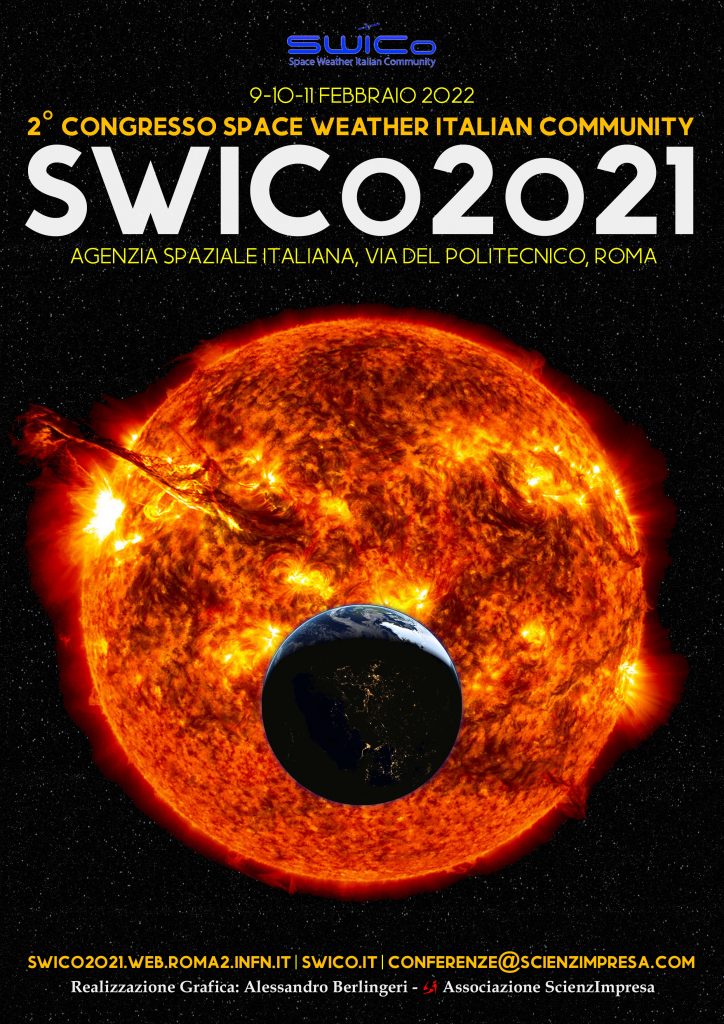
E’ iniziato oggi, 9 febbraio 2022 il “Secondo Congresso Nazionale SWICo” presso la sede ASI di Roma. L’incontro della comunità proseguirà nei giorni 9, 10 e 11 febbraio 2022 (https://swico2021.web.roma2.infn.it/). Il Congresso sarà momento di incontro e confronto dell’intera comunità eliogeofisica italiana impegnata nelle discipline relative allo Space Weather (dal Sole all’interno della Terra). E’ pertanto aperto anche a ricercatori e tecnologi non aderenti a SWICo ed è particolarmente incoraggiata la partecipazione attiva di studenti, dottorandi e giovani ricercatori.
Durante il convegno si terrà anche l’Assemblea Nazionale SWICo per il rinnovo degli Organi Statutari.
Il Congresso offrirà anche l’opportunità del conferimento del Premio “Franco Mariani” (https://swico2021.web.roma2.infn.it/premio-mariani), istituito per onorare la memoria di una personalità scientifica di statura internazionale e rivolto a giovani laureati magistrali in discipline inerenti lo “Space Weather”.
Per ulteriore informazioni sul congresso SWICo raccomandiamo la lettura delle interviste uscite nei giorni scorsi:
https://www.dire.it/07-02-2022/705540-space-weather-il-pericolo-che-viene-dal-sole-%EF%BF%BC/
Quando il Sole fa i capricci

E’ stato recentemente pubblicato un libro divulgativo dedicato allo Space Weather scritto dal Prof. Umberto Villante: Quando il Sole fa i capricci (ed. Dedalo).
Blackout, interruzioni nelle comunicazioni, traffico aereo in tilt, animali e navigatori che perdono la bussola, satelliti fuori uso, pericoli per gli astronauti: le tempeste solari sono sempre esistite, ma oggi il loro impatto sulla nostra società tecnologica può essere devastante. La giovane disciplina denominata space weather, meteorologia spaziale, studia proprio i capricci del Sole e i loro effetti sul nostro pianeta. Villante, tra i massimi esperti del settore, ci guida in modo chiaro e originale nella storia e negli attuali programmi di studio internazionali su queste tematiche, permettendoci di capire a che punto siamo nella comprensione e nella previsione di tali fenomeni. Tra aurore polari, tempeste magnetiche e possibili ripercussioni su milioni di persone, dobbiamo oggi chiederci che tempo farà sul Sole domani.
Course on “Radiation Belt Dynamics and Remote Sensing of the Earth’s Plasmasphere”
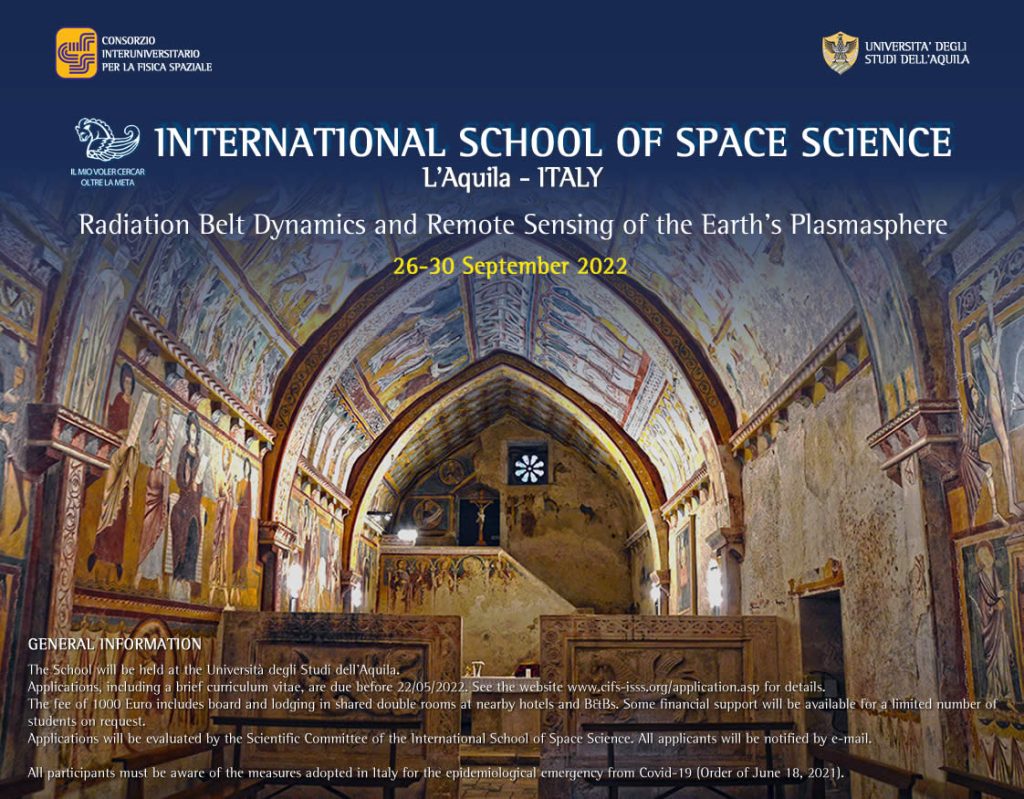
The International School of Space Science of the Consorzio Interuniversitario per la Fisica Spaziale organizes a Course on “Radiation Belt Dynamics and Remote Sensing of the Earth’s Plasmasphere”, to be held in L’Aquila, Italy, 26-30 September, 2022 directed by Prof. János Lichtenberger (Eötvös Loránd University, Budapest, Hungary), Prof. G. Reeves (Los Alamos
National Laboratory, Los Alamos, USA) and Prof. Massimo Vellante (University of L’Aquila, L’Aquila, Italy).
The course is designed for PhD students and young post-doctoral researchers. It will offer an overview of the current knowledge of a key Space Weather region, the radiation belts, and in particular on its related energization and loss processes due to wave-particle interactions, and particle precipitation into the atmosphere. These processes are strongly governed by the properties of the plasmasphere (the outward extension of the ionosphere) which is partially overlapping with the radiation belts. Part of the course will be then devoted to present, both from
a theoretical and observational point of view, as well as through modelling, the basic plasmasphere dynamics, including its coupling with the ionosphere.
Applications are due before May 22, 2022
For more information visit https://www.cifs-isss.org/ or send an e-mail to ssc@aquila.infn.it
Course on “The different spatio-temporal scales of the solar magnetism”
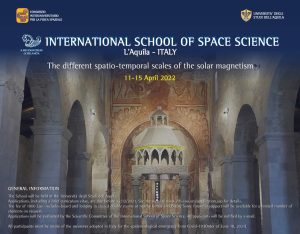
The International School of Space Science of the Consorzio Interuniversitario per la Fisica Spaziale organizes a Course on “The different spatio-temporal scales of the solar magnetism”, to be held in L’Aquila, Italy, 11-15 April, 2022 directed by Prof. F. Zuccarello (Università di Catania, Italy) and Prof. L.Bellot Rubio (Instituto de Astrofisica de Andalucía, IAA-CSIC, Spain).
The School is aimed at providing an in-depth overview of the magnetic phenomena occurring in our star, as well as at presenting some of the most recent tools that can allow to directly tackle the analysis of the problems that are still present in the comprehension of solar magnetic phenomena, through hands-on sessions.
The main topics that will be examined are: the global magnetic field of the Sun and the solar cycle; the small-scale magnetic field: emergence and evolution; the global and local dynamo; the sunspots: processes of formation and evolution and the fine-structure of umbrae and penumbrae; magnetic field instabilities, eruptive events and their impact on Space Weather.
Applications are due before November 21, 2021.
For more information visit https://www.cifs-isss.org/ or send an e-mail to ssc@aquila.infn.it
Secondo Congresso della Space Weather Italian Community (SWICo)

Il “Secondo Congresso Nazionale SWICo” si terrà a Roma presso la sede dell’ASI nei giorni 9, 10 e 11 febbraio 2022 (https://swico2021.web.roma2.infn.it/). Il Congresso sarà momento di incontro e confronto dell’intera comunità eliogeofisica italiana impegnata nelle discipline relative allo Space Weather (dal Sole all’interno della Terra). E’ pertanto aperto anche a ricercatori e tecnologi non aderenti a SWICo ed è particolarmente incoraggiata la partecipazione attiva di studenti, dottorandi e giovani ricercatori.
Durante il convegno si terrà anche l’Assemblea Nazionale SWICo per il rinnovo degli Organi Statutari.
Il Congresso offrirà anche l’opportunità del conferimento del Premio “Franco Mariani” (https://swico2021.web.roma2.infn.it/premio-mariani), istituito per onorare la memoria di una personalità scientifica di statura internazionale e rivolto a giovani laureati magistrali in discipline inerenti lo “Space Weather”.
La scadenza per l’iscrizione, l’invio degli abstract e delle domande di partecipazione al premio è il 30 maggio 2021.




